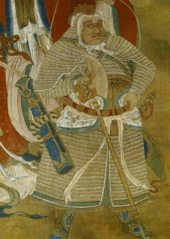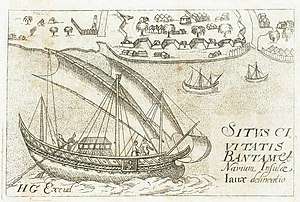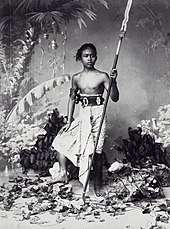Mongol invasion of Java
The Mongol invasion of Java was a military effort made by Kublai Khan, founder of the Yuan dynasty (the leading fragment of the Mongol Empire), to invade Java, an island in modern Indonesia. In 1293, he sent a large invasion fleet to Java with 20,000[5] to 30,000 soldiers. This was a punitive expedition against King Kertanegara of Singhasari, who had refused to pay tribute to the Yuan and maimed one of its ministers. However, it ended with failure for the Mongols and victory for Singhasari.
| Mongol invasion of Java | |||||||
|---|---|---|---|---|---|---|---|
| Part of the Mongol invasions and Kublai Khan's Campaigns | |||||||
| |||||||
| Belligerents | |||||||
|
Mongol Empire Yuan dynasty |
Singhasari Kingdom Kediri Kingdom State of Majapahit | ||||||
| Commanders and leaders | |||||||
|
Kublai Khan (supreme commander) Shi-bi (general) Ike Mese Gaoxing |
Jayakatwang (supreme commander) Raden Wijaya (general), later ruler – allied to Yuan invaders in earlier phases of the war Aria Adikara (naval commander) | ||||||
| Strength | |||||||
|
20,000–30,000 soldiers 1,000 ships |
More than 100,000 soldiers (Mongol claim) 20.000–30.000 soldiers (Java estimates)[1] Unknown number of ships | ||||||
| Casualties and losses | |||||||
|
Shi Bi's Northern Han army: More than 3,000 soldiers killed[2][3] | More than 5,000 killed and drowned | ||||||
Background
Kublai Khan, founder of the Yuan dynasty, the principal khanate of the Mongol Empire, had sent envoys to many states to ask them to put themselves under his protection and pay tribute. Men Shi or Meng-qi (孟琪), one of his ministers, was sent to Java but was not well received there.[6] The king of Singhasari, Kertanagara, was offended by Men Shi's proposal and branded his face with a hot iron as was done to common thieves, cut his ears, and scornfully sent him on his way.

Kublai Khan was shocked and ordered a punitive expedition against Kertanagara, whom he labeled a barbarian, in 1292. The campaign also had other objectives. According to Kubilai Khan himself, if the Mongol forces were able to defeat Java, the other countries around it would submit themselves.[2] The Yuan Mongol Dynasty could then control the Asian sea trade routes, because of the strategic geographical position of the archipelago in trading.[1]
According to the Yuan shi, the history of the Yuan dynasty, 20,000–30,000 men were collected from Fujian, Jiangxi and Huguang in Southern China, along with 1,000 ships and enough provisions for a year.[7] The officers were the Mongol Shi-bi, the Uyghur Ike Mese, who was experienced in overseas voyages, and the Chinese Gaoxing.[8]
Meanwhile, after defeating Malayu Dharmasraya in Sumatra in 1290, Singhasari became the most powerful kingdom in the region. Kertanegara sent a massive army to Sumatra in this Pamalayu campaign. However, seizing the opportunity of the lack of an army guarding the capital, in 1292 Jayakatwang, the duke of Kediri (Gelang-gelang), a vassal state of Singhasari, revolted against Kertanegara. Jayakatwang‘s revolt was assisted by Arya Wiraraja,[9]:199 a regent from Sumenep on the island of Madura, who secretly despised Kertanegara.
The Kediri (Gelang-gelang) army attacked Singhasari simultaneously from both the north and south flanks. The king only noticed the invasion from the north and sent his son-in-law, Nararya Sanggramawijaya (Raden Wijaya) northward to vanquish the rebellion. The northern attack was quashed, but the southern attack successfully remained undetected until they reached and sacked the unprepared capital city of Kutaraja. Jayakatwang usurped and killed Kertanagara during the Tantra sacred ceremony, thus bringing an end to the Singhasari kingdom.
Having learned of the fall of the Singhasari capital of Kutaraja to the Kediri rebellion, Raden Wijaya tried to return and defend Singhasari but failed. He and his three colleagues, Ranggalawe, Sora and Nambi, went into exile to Madura under the protection of the regent Arya Wiraraja, Nambi's father, who then turned to Jayakatwang's side. Kertanegara's son-in-law, Raden Wijaya, submitted to Kediri, brokered by Arya Wiraraja and was pardoned by Jayakatwang. Wijaya was then given permission to establish a new settlement in Tarik timberland. The new settlement was named Majapahit, which was taken from maja fruit that had a bitter taste in that timberland (maja is the fruit name and pahit means bitter).
Military composition
Kublai chose troops from Southern China because they were relatively lightly armored. Light armor was deemed more suitable than heavy armor in Java. Java, as noted by the Khan himself, is a tropical country. There were 5,000 men commanded by Shi Bi, 2,000 from the garrison in Fujian Province, and soldiers from Jiangxi, Fujian, and Huguang provinces. The core was the Northern Han Army, while the rest from the former Southern Song Dynasty. They were familiar with the humid, hot and rainy environment in the south. The Yuan army's armor rate was only 20%, and the Northern Chinese army's was slightly more. They had bows, shields and other ballistic weapons. The heavily armored infantry guards behind these were armed with spears and heavy axes. Mongolian soldiers also brought horses. History of Yuan also mentioned the use of gunpowder weapons, in the form of cannon (Chinese: Pao).[2] The kind of ships used in the campaign is not mentioned in the Yuanshi but Worcester estimates that Yuan junks were 11 m (36 ft) in beam and over 30 m (100 ft) long. By using the ratio between the number of ships and total soldiers, each junk would have been able to carry about 20–30 men.[10]
Yuan Shi recorded that the Javanese army had more than 100,000 men. This is now believed to be an exaggerated or mistaken number. Modern estimates place the Javanese forces at around the same size as the Mongol army, of around 20,000 to 30,000 men.[1] Military forces in various parts of Southeast Asia were lightly armored. As was common in Southeast Asia, most of the Javanese forces were composed of temporarily conscripted commoners led by the warrior and noble castes.[2] The Javanese navy, however, was more advanced than the Chinese. Javanese junks were more than 50 m (164 ft) long, able to carry 500–1000 men, and constructed in multiple thick planks that rendered artillery useless.[11]
Invasion
The Yuan forces departed from the southern port of Quanzhou,[12] traveled along the coast of Trần dynasty Dai Viet and Champa along the way to their primary target. The small states of Malay and Sumatra submitted and sent envoys to them, and Yuan commanders left darughachis there. It is known that the Yuan forces stopped at Ko-lan (Biliton) to plan their strategy. In February 1293, Ike Mese departed first to bring the Emperor's order to Java. The main fleet then sailed to Karimun Jawa, and from there sailed to Tuban. As noted in Kidung Panji-Wijayakrama, they probably looted the coastal village of Tuban. After that, the commanders decided to split the forces into two. The first would advance inland, the second follow them using boats. Shi Bi sailed to the estuary of Sedayu, and from there went to a small river called Kali Mas (a tributary of Brantas river). Land troops under Gao Xing and Ike Mese, which consisted of cavalry and infantry, went to Du-Bing-Zu. Three commanders sailed using fast boats from Sedayu to Majapahit's floating bridge and then joined with the main troops on the way to Kali Mas river.[11]:112[4]:22
When the Yuan army arrived in Java, Raden Wijaya sent an envoy from Madura and informed them that Kertanagara had been killed in a palace coup and the usurper, Jayakatwang, currently ruled in his place.[13] Wijaya allied himself with the army to fight against Jayakatwang and gave the Mongols a map of the country Kalang (Gelang-gelang, another name for Kediri). According to the Yuan-shi, Wijaya attacked Jayakatwang without success when he heard of the arrival of the Yuan navy. Then he requested their aid. In return, Yuan generals demanded his submission to their emperor, and he gave it.[11]:113[4]:23 Raden Wijaya promised a tribute including two princesses should the army succeed in destroying Kediri.[13]
On the 1 March, all of the troops gathered in Kali Mas. At the headwaters of the river was the palace of Tumapel (Singhasari) king. This river was the entryway to Java, and here they decided to do battle. A Javanese minister[Note 1] blocked the river using boats. The Yuan commanders then made a crescent-shaped encampment at the bank of the river. They instructed the waterborne troops, cavalry and infantry to move forward together. The minister abandoned his boats and fled in the night. More than 100 large boats used to block the river were seized by Yuan forces.[11]:114[4]:23
A large portion of the army was tasked to guard the estuary of Kali Mas; meanwhile, the main troops advanced. Raden Wijaya's messenger said that the king of Kediri had chased him to Majapahit and begged the Yuan army to protect him. Because the position of Kediri's army couldn't be determined, the Yuan army returned to Kali Mas. Upon hearing information from Ike Mese that the enemy's army would arrive that night, the Yuan army departed to Majapahit.[11]:114[4]:24
On 7 March, Kediri's army arrived from 3 directions to attack Wijaya. In the morning of 8th, Ike Mese led his troops to attack the enemy in the southwest, but couldn't find them. Gao Xing battled the enemy in the southeast, eventually forcing them to flee into the mountains. Near midday, enemy troops came from the southeast. Gao Xing attacked again and managed to defeat them in the evening.[11]:114[4]:24
On 15 March, the troops split into 3 to attack Kediri, and it was agreed that on the 19th they would meet up in Daha to begin the attack after hearing cannon fire. The first troops sailed along the river. The second troops led by Ike Mese marched along the eastern riverbank while the third army led by Gao Xing marched along the western riverbank. Raden Wijaya and his troops marched in the rear.[11]:115[4]:24
The army arrived at Daha on 19 March. The prince of Kediri defended the city with his troops. The battle lasted from 6.00 to 14.00. After attacking 3 times, Kediri forces were defeated and fled. At the same time that the Mongol and Kediri forces clashed, Majapahit forces attacked the city from another direction and quickly defeated the guards. Jayakatwang's palace was looted and burned.[14] A few thousands Kediri troops tried to cross the river but drowned while 5,000 were killed in the battle. King Jayakatwang retreated to his fortress only to find out that his palace had been burned. The Yuan army then rounded up Daha and called on the king to surrender. In the afternoon, Jayakatwang declared his submission to the Mongols. The Yuan Army captured Jayakatwang, his son, wife and all his officers, and captured loot worth 50 million yuan.[11]:115[4]:24
Once Jayakatwang had been captured by the Mongols, Raden Wijaya returned to Majapahit, ostensibly to prepare his tribute settlement, and leaving his allies to celebrate their victory. Shi-bi and Ike Mese allowed Raden Wijaya to go back to his country to prepare his tribute and a new letter of submission, but Gaoxing disliked the idea and he warned the other two. Wijaya asked the Yuan forces to come to his country unarmed, as the princesses could not stand the sight of weapons.[11]:109 and 115[4]:24
Two hundred unarmed Yuan soldiers led by two officers were sent to Raden Wijaya's country, but on 19 April Raden Wijaya quickly mobilized his forces again and ambushed the Yuan convoy. After that Raden Wijaya marched his forces to the main Yuan camp and launched a surprise attack, killing many and sending the rest running back to their ships. Upon reaching a temple, the Yuan army was ambushed by the Javanese army. They managed to make a breakthrough in the middle, continuing their 123 km rout eastward. Raden Wijaya did not engage the Mongols head on; instead, he used all possible tactics to harass and reduce the enemy army bit by bit. During the rout, the Yuan army lost all of the spoils that had been captured beforehand.[11]:115[4]:25

A number of Mongol ships were attacked and destroyed by the Javanese fleet commanded by rakryan mantri[Note 2] Aria Adikara.[15][16] The Yuan forces had to withdraw in confusion, as the monsoon winds to carry them home would soon end, leaving them to wait in a hostile island for six months. After all of the troops had boarded the ships on the coast, they battled the Javanese fleet.[Note 3] After repelling it, they sailed back on 24 April to Quanzhou in 68 days.[2] Shi Bi's Northern Han army lost more than 3,000 soldiers, while the newly formed troops lost more.[3] Modern research by Nugroho estimated 60% of the Yuan army was killed (with total losses of 12,000–18,000 soldiers),[1][4] with an unknown number of soldiers taken prisoner and unknown number of ships destroyed.[12][15][2] In June 1293, the army arrived in China. They brought Jayakatwang's children and some of his officers, numbering more than 100. They also acquired the nation's map, population registration and a letter with golden writings from the king.[2]
Aftermath
The three generals, demoralized by the considerable loss of their elite soldiers due to the ambush, went back to their empire with the surviving soldiers. Upon their arrival, Shi-bi was condemned to receive 70 lashes and have a third of his property confiscated for allowing the catastrophe. Ike Mese also was reprimanded and a third of his property taken away. But Gaoxing was awarded 50 taels of gold for protecting the soldiers from a total disaster. Later, Shi-bi and Ike Mese were shown mercy, and the emperor restored their reputation and property.[17]
This failure was the last expedition in Kublai Khan's reign. Majapahit, in contrast, became the most powerful state of its era in the region.[18] Kublai Khan planned another invasion of Java with 100,000 strong army, but this plan was cancelled after his death.[2] Travellers passing the region, such as Ibn Battuta and Odoric of Pordenone, however noted that Java had been attacked by the Mongols several times, always ending in failure.[19][20] Gunung Butak inscription from 1294 mentions Aria Adikara intercepting a further Mongol invasion and successfully defeating it before landing in Java.[16]
This invasion introduced gunpowder to Nusantara archipelago,[21]:245 which Mahapatih (prime minister) Gajah Mada would utilize its use in Javanese naval fleet during Majapahit conquest.[22]:57
Notes
- This is translated from Chinese word, it is likely that it meant to represent mantri (Javanese word). While in modern Indonesian mantri means menteri (minister), historically the may refer to officer or military officer.
- The Council of Ministers of Majapahit is composed of five officials who function as the governing body of the government called Rakryan Mantri. The word itself means noble/high officer.
- The original transcription is zhǎowā chuán, which means Javanese junk ship.
See also
- Mongol invasions of Vietnam, another Mongol invasion of Southeast Asia
- Mongol invasions of Japan, another Mongol naval expedition
- Cetbang, Majapahit gunpowder powder whose technology was obtained from this incursion
- Bedil, a term for gunpowder-based weapon of the region
References
- Nugroho, Irawan Djoko (2011). Majapahit Peradaban Maritim. Jakarta: Suluh Nuswantara Bakti.
- Song Lian. History of Yuan.
- Shi Bi's notes book 162.
- W.P Groeneveldt (1880). Notes on the Malay Archipelago and Malacca Compiled from Chinese Sources. Batavia.
- Weatherford, Jack (2004), Genghis khan and the making of the modern world, New York: Random House, p. 239, ISBN 0-609-80964-4
- Grousset, Rene (1988), Empire of steppes, Wars in Japan, Indochina and Java, New Jersey: Rutgers University Press, p. 288, ISBN 0-8135-1304-9.
- Weatherford (2004), and also Man (2007).
- George Coedès. The Indianized States of Southeast Asia.
- Cœdès, George (1968). The Indianized states of Southeast Asia. University of Hawaii Press. ISBN 9780824803681.
- Worcester, G. R. G. (1971). The Junks and Sampans of the Yangtze. Naval Institute Press. ISBN 0870213350.
- Nugroho, Irawan Djoko (2011). Majapahit Peradaban Maritim. Suluh Nuswantara Bakti. ISBN 9786029346008.
- Sen, Tan Ta; Dasheng Chen (2009), Cheng Ho and Islam in Southeast Asia, Institute of Southeast Asian Studies, p. 186, ISBN 9789812308375
- Burnet, Ian (2015). Archipelago: A Journey Across Indonesia. Rosenberg Publishing. ISBN 9781925078718.
- Berg, C.C. (1931). Kidung Harsa-Wijaya. S-Gravenhage: Martinus Nijhoff.
- Berg, C.C. (1930). Rangga Lawe, Middeljavaansche Historische Roman, BJ 1. Weltevreden: Albert & Co.
- Nugroho, Irawan Djoko (2009). Meluruskan Sejarah Majapahit. Ragam Media. ISBN 978-9793840161.
- Man 2007, p. 281.
- Saunders, J. J. (2001), The history of Mongol conquests, Philadelphia: University of Pennsylvania Press, ISBN 0-8122-1766-7.
- da Pordenone, Odoric (2002). The Travels of Friar Odoric. W. B. Eerdmans Publishing Company.
- "Ibn Battuta's Trip: Chapter 9 Through the Straits of Malacca to China 1345–1346". The Travels of Ibn Battuta A Virtual Tour with the 14th Century Traveler. Berkeley.edu. Archived from the original on 17 March 2013. Retrieved 14 June 2013.
- Manguin, Pierre-Yves (1976). "L'Artillerie legere nousantarienne: A propos de six canons conserves dans des collections portugaises". Arts Asiatiques. 32: 233–268.
- Pramono, Djoko (2005). Budaya Bahari. Gramedia Pustaka Utama. ISBN 9789792213768.
Further reading
- Bade, David W. (2002), Khubilai Khan and the Beautiful Princess of Tumapel: the Mongols Between History and Literature in Java, Ulaanbaatar: A. Chuluunbat
- Man, John (2007), Kublai Khan: The Mongol king who remade China, London: Bantam Books, ISBN 978-0-553-81718-8
- Levathes, Louise (1994), When China Ruled the Seas, New York: Simon & Schuster, p. 54, ISBN 0-671-70158-4,
The ambitious khan [Kublai Khan] also sent fleets into the South China Seas to attack Annam and Java, whose leaders both briefly acknowledged the suzerainty of the dragon throne
- d'Ohsson, Constantin Mouradgea (2002), "Chapitre 3 Kublai Khan, Tome III", Histoire des Mongols, depuis Tchinguiz-Khan jusqu'à Timour Bey ou Tamerlan, Boston: Adamant Media, ISBN 978-0-543-94729-1

.jpg)